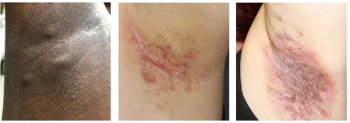
HS Excision Clinical Pearls Discussed at AAD Annual Meeting
How can you improve excision care for your patients with hidradenitis suppurativa? Ashley Nicole Elsensohn, MD, MPH, FAAD, shared clinical pearls at the AAD Annual Meeting.
From managing patient expectations to choosing the best techniques for success, Ashley Nicole Elsensohn, MD, MPH, FAAD, shared clinical pearls for hidradenitis suppurativa (HS) lesion excision at the 2024 American Academy of Dermatology Annual Meeting.1 Elsensohn is an assistant professor of dermatology and an assistant professor of pathology and human anatomy in the Pathology Division of Loma Linda University School of Medicine and a Mohs surgeon.
Choosing the best method depends on many factors, Elsensohn told Dermatology Times in an interview. For instance, when a patient needs immediate relief for an intense, acute, painful abscess, she will consider a simple incision and drainage procedure. After that, she may consider deroofing procedures if she is addressing a simple abscess or sinus tract. Unfortunately, deroofing leads to a 25% chance of recurrence, and can be an issue in patients with stage 3 HS.2 In those cases, Elsensohn considers lesional or regional excisions.
There are a number of factors to consider for managing and mitigating post-operative complications, according to Elsensohn. “Generally, patients do very well,” she told Dermatology Times. Preparing patients can be key to successful outcomes, she said. Because patients with HS have experience with wounds that are painful, they are aware of potential issues and make for good partners in surgical procedures.
“If we look at postsurgical pain after the first week of HS recovery, about 25% of patients have a pain scale of 1 to 4 on a scale of 10, with 10 being the most severe” she explained. Often patients report a little bit of drainage and that the pain was tolerable.
“There's even been some studies that show if you ask patients how bad was their first week of recovery as far as pain goes, only 3% of patients say that their pain was worse than an HS flare,” Elsensohn noted. “So that kind of reassures patients when I put it in that sort of context.”
“Some of the little tricks that I do sometimes if I still have a little wiggle room is that I can give a little extra anesthetic. I'll give bupivacaine right before they leave just so they don't have any pain until later that night,” she said.
Elsensohn also likes to let patients’ wounds granulate. “There's lower chance of infection and less chance of recurrence with granulation,” she added. “So I keep them in the office for at least 5 to 10 minutes after the procedure just to make sure there's no bleeding and that the site is very, very dry.”
Granulating tends to worry patients initially she said. “They think, ‘Oh, I have an increased chance of infection because I have this open wound.’”
She explains to patients that preventing postoperative infection is fairly easy, and things that they are generally comfortable doing. She reminds patients they will need to put on a topical antibiotic cream every day and wash thoroughly with soap and water.
Reassurances also make patients feel better, she said. “I show them some before and after photos, which also reassures patients so they kind of know what to expect,” Elsensohn explained. “I think it's just kind of laying out the expectations and explaining the thought process. Generally, patients do very well and are very happy afterwards. They don't tend to have too many questions in the postoperative period if we do really good counseling beforehand.”
For continued coverage of the 2024 AAD Annual Meeting, visit DermatologyTimes.com regularly and follow us on social media.
Are you attending the conference? Share your insights, perspectives, comments, and session summaries with us via
References
1. Elsensohn AN. Hidradenitis Suppurativa excision pearls. Quick fire surgical pearls to optimize patient outcomes. AAD Annual Meeting; March 8- 12, 2024; San Diego, California.
2. Block R, Chao T, Maloney V, PER Editorial Staff.
Newsletter
Like what you’re reading? Subscribe to Dermatology Times for weekly updates on therapies, innovations, and real-world practice tips.

















